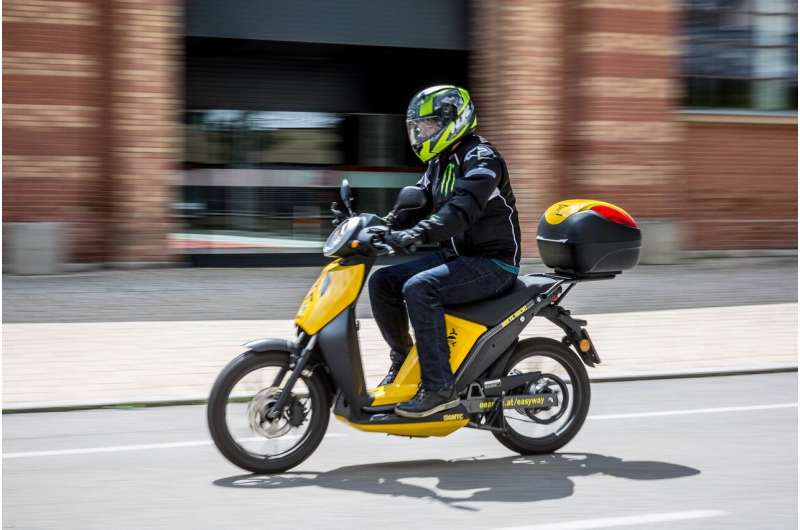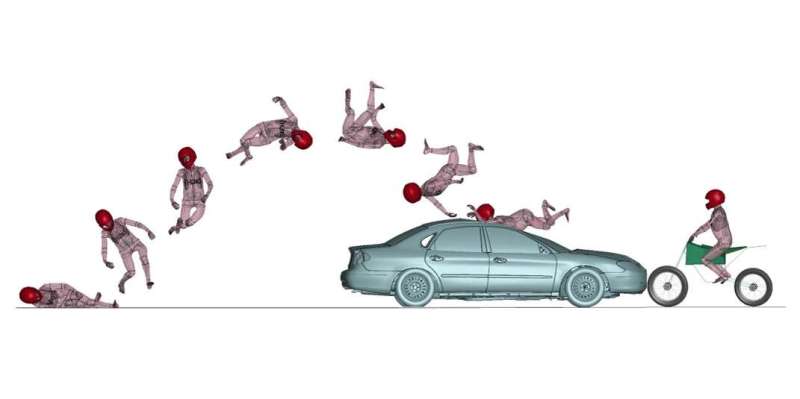Researchers from the Institute of Vehicle Safety at Graz University of Technology, together with experts from the ÖAMTC, investigated the influence of the right moped helmet on the risk of injury. Credit: ÖAMTC/Bauer
Joint investigations by researchers from Graz University of Technology and the ÖAMTC show that the risk of serious head injuries increases when an already damaged helmet or a wrong helmet is worn.
In Austria, more than 4,100 moped riders are injured in road accidents every year—including many young people. Despite the fact that it is compulsory to wear a helmet and that helmet wearing compliance is high, head injuries occur time and again. The Institute of Vehicle Safety at TU Graz, in cooperation with the ÖAMTC (an Austrian automotive club) and the association "Große schützen Kleine" investigated how different types of helmets behave in accident situations, how well they protect riders and how moped riders can also minimize the risk of injury. The project was funded from the Austrian Road Safety Fund (VSF) set up by the Federal Ministry for Climate Protection, Environment, Energy, Mobility, Innovation and Technology (BMK).
Replace the moped helmet after a collision
Computer-aided simulations carried out by TU Graz showed that drivers are much more likely to suffer serious head injuries if they are wearing a moped helmet which has already been damaged. "If another impact occurs at the same place on the helmet, the risk of serious head injuries increases by up to 19 percent. The reason for this is that the foam structure inside the helmet deforms greatly to dissipate energy in the event of an impact. But this energy dissipation is only possible once," explain TU Graz scientists Desiree Kofler and Corina Klug from the Institute of Vehicle Safety. The tests show that the deformation also occurs when the helmet appears completely undamaged on the outside after an impact.
Motocross helmet with dangerous lever effect
The researchers also warn against wearing a motocross helmet instead of a moped helmet. Such a helmet has a chin guard that extends forward to provide improved airflow when riding motocross. However, the tests and simulations showed that this chin guard acts like a lever and can promote the rotation of the helmet in the event of an impact. This resulted is greatly increased stress in the area of the cervical spine, especially if the helmet fits too closely.
Computer simulations with a virtual human model at the Institute of Vehicle Safety showed that the risk of head injuries increases if an incorrect helmet is worn. Credit: TU Graz / VSI
"The optimal fit of a crash helmet is always extremely important," explains ÖAMTC technician Dominik Darnhofer. "A helmet that is too loose or too tight offers inadequate protection against injury." When buying a helmet, the regular tests of the automotive club provide orientation. However, you still have to try out different sizes. "We advise you to take a test drive before buying and to test the helmet in practice. This is the only way to determine whether it really fits," Darnhofer clarifies.
In addition to the head, riders' arms and legs are particularly at risk of injury. To avoid superficial injuries Darnhofer recommends wearing sturdy shoes, gloves and long trousers and long sleeves. "The latter at best in the form of a moped jacket."
Raising awareness for greater road safety
The investigations fit seamlessly into the road safety measures of the BMK. Climate Protection Minister Leonore Gewessler: "Comprehensive safety on Austria's roads concerns all road users—from pedestrians to truck drivers. We are therefore investing both in research for greater road safety and in raising awareness, currently with the campaign "Caution drives better." Because especially in the moped and motorcycle season, we want to focus on the right behavior for two-wheelers. The Protect Me project carried out by the ÖAMTC, Große schützen Kleine and TU Graz shows that the right helmet which is also well-fitting can save lives!"
The Protect Me project investigated the influence of protective equipment on the degree and type of injuries in moped accidents in order to derive recommendations. The researchers used prospective data from a questionnaire study by the University Hospital Graz and carried out experiments on different helmet types and simulated accident scenarios using a virtual human model. In addition, they investigated the influence of different helmet parameters on the risk of injury in a sensitivity study.
Provided by Graz University of Technology























